 |
[ Outlaw Genealogy | Bruce
History | Lost Chords ] [ Projects | News | FAQ | Suggestions | Search | HotLinks | Resources | Ufo ] |
 |
[ Outlaw Genealogy | Bruce
History | Lost Chords ] [ Projects | News | FAQ | Suggestions | Search | HotLinks | Resources | Ufo ] |
We may in fact be related to the ancient family of "De Clare" - > the famous Clere family of Stokesby Blickling Norfolk :
Notice that Margaret Walshe s' mother was Olive - daughter of Robert CLERE of Stokesby
Notice the Outlaw connection to Pembroke (Bristol Wales) Killkenney (Dublin Ireland) and "de Burgh's" This later Robert de Clere married Alice Boleyn - This all goes to point to how the Outlaw's were their men.
This also shows how the relationship with King Henry VIII of Adam Outlawe and Simon Outlawe with the Clere's and the Walshes
Notice also that the grandmother of Margaret Walshe was Cicilie Daughter of Sir John Harseck (Harsyck) whose brass is found Castle (South) Acre
Notice Margaret nee Walshe married John Outlaw of Dereham and
had four children:
John Outlaw, Catherine Outlaw, Joane Outlaw, Cecily Outlaw
We would like to connect DATES to these children - especially the son, John Outlawe as this might be our original Capt. John Outlawe in Virginia
1384 - Sir John Harsyck and his wife Katherine
1393 - Sir Thos. Walsch and Dame Katherine his wife
1451 - Robert Walshe, son of Thomas, who was born perhaps before 1451. He married Cecilly Harsyck, daughter of Sir John Harsyck, and their sons included a Robert and William Walshe.
Lady Margaret Butler (Boleyn) - (c. 1454 or 1465 – 1539)
1488 - Robert Clere of, Stokesby, Norfolk, England d. Bef 5 Nov 1488
Alice Boleyn c. 1487 - 1538 married Robert Clere
Family Elizabeth Brampton, of, Brampton, Norfolk, England d. 1533
Married STATUS: 2nd marriage for wife. [4]
Children
1. Edward Clere, b. Cal 1483, of, Stokesby, Norfolk, England , bur. 11 Dec
1575, Stokesby, Norfolk, England n
2. Sir Thomas Clere, Knight, of, Stokesby, Norfolk, England d. 23 Nov 1553
3. Olive Clere, of, Stokesby, Norfolk, England d. Yes, date unknown
4. Bridget Clere, d. Yes, date unknown
1494 - Thomas and Margaret Walsh, Colby, Norfolk, dated 1494
1499 - Roger Walsh of Blickling (d. 1499) Probate
1499 - William WALSH married Olive CLERE on 1499 in Colby, Norfolk, England.- William Walshe marries his second wife, Olive, daughter of Robert Clere of Stokesby in Norfolk
1503 - Robert and Margery Walsh, Colby, Norfolk, dated 1503
William WALSH married Olive CLERE had children named William, Ursula (m. John Colbye) and Elizabeth (m. Robert Clarke) and - Margery ( Margaret ) (m. John Owtlawe of Est Derham), Date ?
1544 - Feoffment. William Walsh of Colby, gent., to Robert Purdy, chaplain of Colby. - 28 Jan 1544
1567 - Outlaw (Owtelawe), John, elder, joiner, of East Dereham - Will. (A Joiner - Fine woodworker without using nails) ?
Does this Cecily have anything do with this:? (TheWalshe family also had Cecily's so this is probably an homage to the wifes family...
But notice there is a John Outlawe (but no brother Edward)
1279 - June 12 Rochester - Simple Protection, for three years, for David de Pembrok, and Cecil[ia] la Utlaghe - Kings Writ - 7 Edward I - (Every indication is that Cecilia Utlaghe was from Ireland along with David de Pembrok and in England for schooling ) Earliest record of an Utlaghe from Ireland !
The Ireland connection:
County Kilkenny Surname Histories
Walsh - Walsh is among the five most numerous surnames in Ireland, found throughout the country. There are concentrations of Walshes in Leinster in counties Kilkenny and Wexford, in Connacht in counties Mayo and Galway, and in Munster in counties Cork and Waterford.
Walsh is a semi-translation of the Irish surname Breathnach, meaning
'Welsh' or 'Breton', also sometimes anglicised as 'Brannagh'. This
alludes to a Cambro-Gaelic origin of the Walsh families. 'Philip of Wales',
a hero in a naval battle of 1174, is thought to be an ancestor of the Walshs in
the Mountains of south-central County Kilkenny. Lawrence Walsh compiled a
genealogy in 1588 and claimed the Walshs of the Mountains, among other Walsh
families, were descended from Walynus, a Welshman who came to Ireland with
Maurice Fitzgerald in 1169. The leading members of this family established
themselves as landed gentry at Castlehowel (Co. Kilkenny), at Ballykileavan (Co.
Leix), at Ballyrichmore (Co. Waterford) and also at Bray and Carrickmines near
Dublin.
...
For early history on the Walshs, see Walsh Family Genealogy and History.
Walsh, Walshe, Welsh (et al) of England
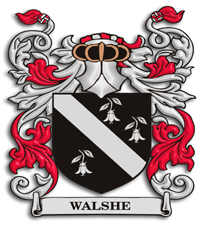 Colbye
Colbye
The arms of Walshe of Colbye are described in a pedigree published in the
The visitacion of Norffolk (Harleian Society, v. 32, 1891). The
description is 'Sable, a bend between three lilies (columbines?) slipped
and leaved argent.'
The head of the family in this pedigree was Thomas Walshe, whose
children included Robert, Roger, Jefferey, Joane, and Cecilly. The
remaining portion of the pedigree focuses on Robert Walshe, son of Thomas,
who was born perhaps before 1451. He married Cecilly Harsyck, daughter of
Sir John Harsyck, and their sons included a Robert and William Walshe.
Another description of the Walshe arms are given as "Sable, a bend
between three lilies, Argent, stalked vert." These were the quarterings
of Sir Andrew Fountaine, knight, in 1725, and are quartered with Walshe, Harsick,
Damme, Briggs and Beaupre. [source: An essay towards a topographical history of
the county of Norfolk, 1807]
William Walshe son of Robert and Cecilly, born in the latter half of the 15th
century, was married three times.
By his first wife, Margaret, dau. and heir of Simon Dane [Damme] of Susted in
Norfolk, their children included Robert, Ella (m. three times) and Elizabeth (m.
Arthur? Fountayne & Richard Stone).
By his second wife, Olive, daughter of Robert? Clere of Stokesby in Norfolk,
they had children named William, Margery (m. John Owtlawe of Est Derham),
Ursula (m. John Colbye) and Elizabeth (m. Robert Clarke).
By his third wife, Ann, dau. and heir of Robert Kebyll of Felmingham in Norfolk,
their daughters included Margery (m. William Russell & Robert Gabyn) and
Elizabeth (m. Thomas Bulwer of Wood Dalling).
NOTE: a second pedigree (ibid.) suggests that Elizabeth, dau. of
William and Margaret (Dane or Dame) Walshe, was married to Mathew Fountayne of
Salle in Norfolk. Among their children included Arthur (the heir), George and
Elizabeth. [source: An essay towards a topographical history of the county of
Norfolk, 1807]
William Walshe, the younger, of Colbye in Norfolk, son and heir of William and
Olive (Clere) Walshe, was married twice. His first marriage was to Bridget, dau.
of Rob. Thymblethorpe of Worsted in Norfolk. William married second, Ann, dau.
of Sir James Framyngham in Suffolk, knight. A daughter of William and Ann was
named Elizabeth
Norfolk Churches - St Giles, Colby
A brass at Colby Church commemmorates Thomas Williach or Walysh and
Margaret his wife of Colby and Antingham. Will 1452.
[Norfolk Archaeology; v. 32; 1961]
Two other inscriptions commemorate members of the same family but in different
churches: one at Colby commemorates Thomas Walsh (d.1451) and Margaret his
wife (d. 1494); the other at Blickling commemorates Roger Walsh (d.
1499). [source: Church Monuments in Norfolk Before 1850: An
Archaeology of Commemoration; Jonathan Finch; 2000]
An inscription for Thomas and Margaret Walsh, Colby, Norfolk, dated 1494. And
an inscription for Robert and Margery Walsh, Colby, Norfolk, dated 1503.
[source: Norfolk Archaeology, v. 26; 1938]
Norfolk
Churches - St Andrew, Blickling - The brasses are a reminder of
Blickling's association with one of the great tragic figures of English history
before its rebuilding; several are to the Boleyn family, and Anne Boleyn, second
wife of Henry VIII, grew up here. The Felthorpe family is depicted in its
entirety, with eleven sons and five daughters. Most moving is Anne Wode, who
carries her two dead babies in her arms. The best are, perhaps, the smaller
figures, although the lifesize Sir Nicholas Dagworth is rather fine. ...
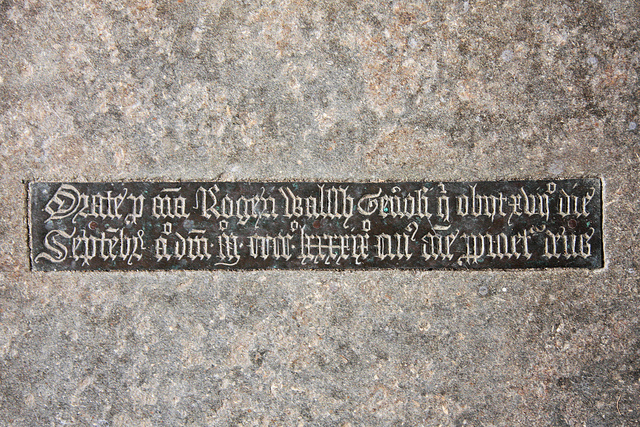 Brass
inscription to 1499, - Roger Walsh, Blickling St Andrew Church, Norfolk
Brass
inscription to 1499, - Roger Walsh, Blickling St Andrew Church, Norfolk
Orate pro anima Rogeri Walsh, Benerosi, qui obiit rbii die Septemb' Anno Dni. Moccccolxxxxix. cuius anime propicietur Deus.
The inscription is to Roger Walsh, generosi (gentleman) who died in 17th day of September 1499
Page 260:
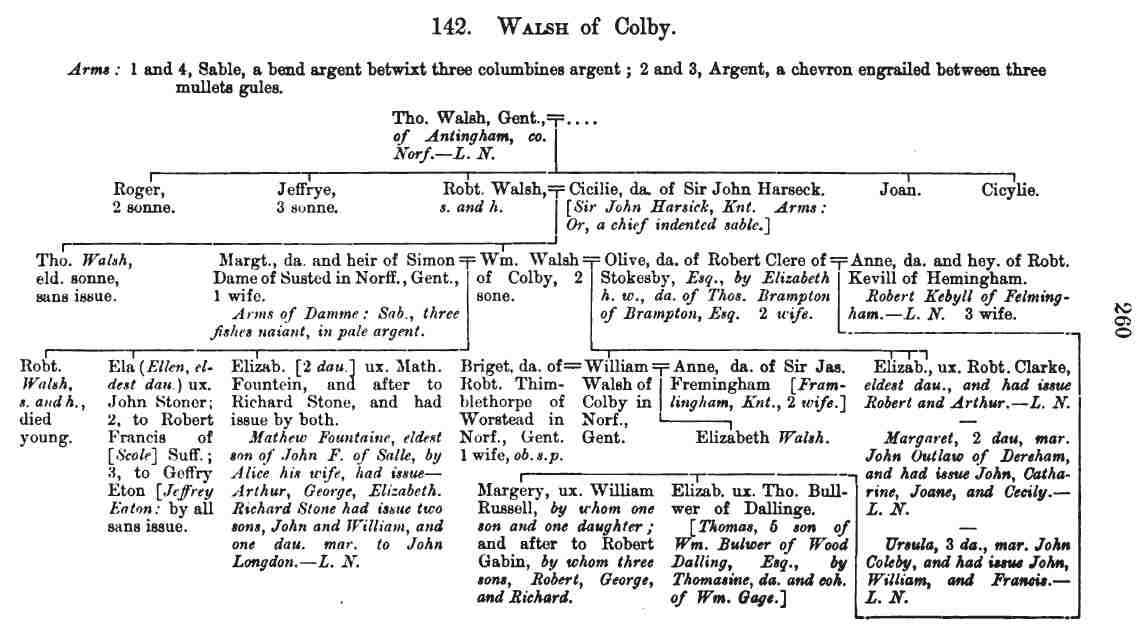
1567 - Outlaw (Owtelawe), John, elder, joiner, of East Dereham - Will. (A Joiner - Fine woodworker without using nails) ?
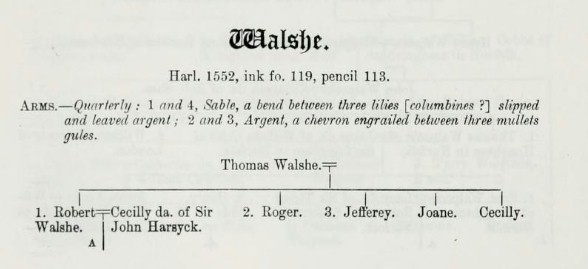
The Gentleman's Magazine - John Nichols
| - - - -
The early association to the De Clare family in Ireland / Gloucestershire - Bristol But he dies fighting Robert the Bruce so what happened then? Need to find out more about Nicolas de Balscote - one would have to assume they presided over de Clare's will:
1313 - Earl
of Gloucester & Hereford names William OUTLAWE as one
of his attorneys. - Gilbert
de Clare, 8th Earl of Gloucester 1291-1314 (Ireland?) - Calendar
of the Patent rolls Vol-1 - Gilbert de Clare letters nominating Nicolas
de Balscote and William OUTLAWE as his attorneys in Ireland for 5
years
1313 - Gilbert
de Clare, Earl of Gloucester and Hertford, staying in England,
Westminster, has letters nominating Nicholas de Balscote and William Outlawe
his attorneys in Ireland for five years. May 1 - Westminster
1313 - Willielmus Outlagh - The Tallage of 6 Edward II - Bristollia Bristol - Tallage - Bristollia or, memoirs of the city ... - Gloucestershire - Bristol
1314 - Battle of Bannockburn - June 24 - Robert the Bruce defeats Edward II Army - After Earl of Gloucester was killed, the English army soon fell into disarray, and the battle resulted in a resounding victory for the Scots, and a humiliating withdrawal for the English. Robert the Bruce was the earl's brother-in-law ( Maud de Burgh ), and mourned his death
Nicholas de Balscote - ( died 1320 ) was an English-born official and judge in fourteenth-century Ireland: he achieved high office but was ruined by a quarrel with the Crown. ... He was born at Balscote in Oxfordshire, and was probably of the same family as Alexander de Balscot ... He is first heard of as an official of the Exchequer of Ireland in 1303, and was subsequently appointed Archdeacon of Glendalough. He became Chancellor of the Exchequer of Ireland in 1310, and Chief Baron of the Irish Exchequer in 1313.[3] In 1317 he was spoken of as Lord Chancellor of Ireland but not appointed. He became custodian of the Archdiocese of Dublin in the same year.
| - -- - -
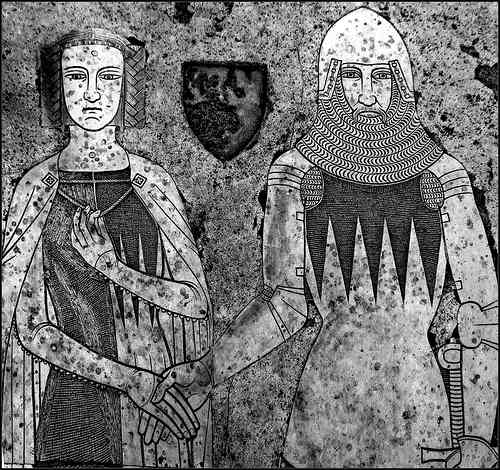 what
will survive of us is love - detail of the brass memorial
to Sir John Harsyck and his wife Katherine, 1384.
what
will survive of us is love - detail of the brass memorial
to Sir John Harsyck and his wife Katherine, 1384.
Nearby Castle
Acre is more famous, but the church of St
George at South Acre is both beautiful and interesting. The most famous
feature is the huge alabaster table monument to Sir Edward Barkham and his wife
1539 - Outlaw: pensioner - Gonville and Caius College, Cambridge
1541 - Adam
Owtlawe - (£30) - '1541 London Subsidy roll: Tower Ward
1542 - Simon
Owghlawe owns land in Upton, afterwards possessed by Thomas Clere, 1542.
Thomas Clere
also had land here which formerly belonged to John Reynes of Acle. — Court of
Wards and Liveries, vi. 129.
1542 - Simon
Owghlawe - Outlawe -
land in Acle, Mowton, Boyton, Northbyrlyngham Fysshely and Upton
1543 - Adam
Owtlawe - send four ships to the Downes - Feb 23 - Sir Francis
Bryan to the Kings Council - Scotch prisoners - (Sir
Francis Bryan was a distinguished diplomat,
soldier, sailor,
cipherer, man
of letters, and poet.)
(Henry VIII)
1543 - Westminster., 19 Feb. Bryan ^ ' that the King is advertised of the troubles we were in upon the seas and the danger and ruin of his ships, and that I was determined according to your commandment to send four ships to the Downes. The said ships were ready in Humber before the receipt of your letters, whereupon I sent a boat which has spoken with Mr. Clere and Mr. Carye, commanding them to lie off and on upon the coast between Humber and Newcastle, and as Mr. Nedygate and Adam Owtlawe were ready victualled I thought it more convenient that they should accompany Mr. Clere and Mr. Carye, than lie in harbour.
As Clere and Carye went forth of Humber they met a Scot of 30 tons laden with salmon, herring and barrelled fish with the lord Admiral's safe-conduct for George Browne and Ant. Papeworth, of Barwike, to bring, in Scottish ships or boats, certain fish to Berwike, Holy Hand, Aylmouth or Stakton at price therein limited (given). As the Scot had passed the places appointed and said he was going to Boston, Sir John [Clere] and Mr. Carye sent him to Hull, and I have stayed him and certified my lord Admiral. Clere also took a French boat, as I reported, which is at Newcastle, and the men, 31 and 3 Dutchmen, brought in the ships to Hull, and I have, by advice of Mr. Stanhop, delivered all 34 to the mayor to keep them and see them gently handled. Begs to know how their charges shall be paid. Here awaits the coming of Mr. Osborn with the King's further pleasure. The French have delivered an inventory of their goods, valued at 500 mks., which is sent to the lord Admiral. Hull, 23 Feb. Signed. Pp. 2. Add. Endd. : a xxxiiij .
[ Notice that Sir Francis addresses his "peers" as Mr. - Mister - (Master) and others like Adam Owtlawe, by their first and last names. ]
1544 - July 1544 Expedition to Calais - Captain Adam Owtlawe
1544 - Owtlawe, Adam, [no place] 21 pynnyng - Prerogative Court of Canterbury - Probate Wills page 397 - Is this the same man? Did he die at sea? He was alive in October, this reference has just the year , no month (FYI - This is the court that would be used for someone who had died at sea).
1545 - Will of Adam Owtlawe - 09 January 1545 - Records of the Prerogative Court of Canterbury - Pynnyng - The PCC was the most important of these courts dealing with relatively wealthy individuals living mainly in the south of England and most of Wales. If a property-owner in England or Wales died overseas, such as sailors or soldiers, then their will was proved in the Prerogative Court of Canterbury regardless of where their property was held. - Adam Owtlawe Will - Had a wife named Alice and a son named Thomas and/or a son named Adam (it is very hard to read, so if know old wills, have a look and let me know.)
1545 - Dec
22 - For a weye of salt delivered to Brymer Outlawe, 30s.
14l. 16s. 8d. - Henry VIII: Papers - Somehow Related? Relative of
Adam? BRYMER is of Belgium origin, a locational name meaning
'one who lived by the sea-shore'. Not a common first name.
The "weye of Salt" may have been a bereavement gift from Henry
VIII no less.
This was Sir John Clere:
CLERE, Sir John (1511-57), of London, Norwich and Ormesby, Norf. History of Parliament Online
The first son of his father’s second marriage, John Clere benefited little from the succession because part of the Clere estate was held by his half-brother’s widow and most of the remainder stayed with his mother during her life. That Sir Robert Clere mistrusted his son’s habits appears from the condition which he attached to a bequest of plate and a gold chain, ‘that he avoid riot and great gaming’, although as Sir Thomas Tyrrell, whose daughter John Clere married, was later to complain that he had been left not only to pay for the marriage feast but also to keep the couple in food and lodging for seven years, there does not appear to have been much scope for extravagance.3
Clere’s position improved in 1538, when on his mother’s death he gained possession of nearly 20 manors, mainly on the east coast of Norfolk: in the following year he was knighted and in 1540 he was put on the Norfolk bench. Thirteen years later he added to his patrimony the reversion of three manors bought from his uncle Sir James Boleyn, among them the future family seat of Blickling. Rarely on good terms with his neighbours, above all the Pastons, Clere was not infrequently in the Star Chamber, where one complainant criticized his ‘covetous appetite and ungodly disposition’. At least in Henry VIII’s time he could treat such attacks the more lightly in that he enjoyed the patronage of the Howards: the 3rd Duke of Norfolk had been overseer of his father’s will and his younger brother Thomas, a servant of the Earl of Surrey, was to be commemorated in one of Surrey’s sonnets after dying from wounds received when he saved the earl’s life in France in 1545. It was during this phase of Clere’s career that he attended his first two Parliaments as Member for Bramber, one of the Howard boroughs in Sussex. He was one of a group around Surrey arrested during the second session of the Parliament of 1542 for eating flesh in Lent.4
If it was as a courtier and a dependant of the Howards that he first came to public notice, it was as a naval captain and an administrator that Clere made his name. Early in 1548 he commanded a patrol in the North Sea and two years later he served in the Channel. His service at sea commended him to the admiral John Dudley, Viscount Lisle, whom in 1546 he accompanied to France to negotiate peace. Presumably he served under Dudley’s successor as admiral, Thomas, Baron Seymour of Sudeley, but nothing has come to light about his part in the Scottish war. Clere’s plundering of West Somerton church perhaps helped to foment Ket’s rebellion during 1548: he answered the Marquess of Northampton’s call for support from Norfolk gentlemen and after Northampton’s replacement by Dudley, then Earl of Warwick, he assisted in restoring order. Dudley rewarded him with lands said to have been promised to him by Henry VIII and with the treasurership of the army stationed in northern France until the surrender of Boulogne in 1550. His closeness to Dudley probably accounts for his Membership of the Parliament of March 1553 as much as his friendship with the leading resident at Thetford, Richard Fulmerston. During the succession crisis Clere seems to have declared for Lady Jane Grey and to have prevented a military force from Great Yarmouth from reaching Mary. When the tide turned in Mary’s favour his arms were impounded but he is not known to have been imprisoned.5
Clere sued out a pardon in October 1553 but was not reappointed to the commission of the peace. The marriage of his daughter to the Protestant Walter Haddon suggests that his sympathies were still on that side. His election as first knight of the shire for Norfolk in 1555 can thus scarcely have pleased the court and may have owed little to the new duke. In the Commons he had the bill enabling merchants to take coin out of the realm committed to him after its second reading on 22 Nov., but he did not align himself with the opposition as did his fellow-knight John Appleyard, and his appointment as vice-admiral at Portsmouth in the following year shows that he was regarded as politically reliable as well as professionally competent. His first mission, to escort Charles V on his voyage to retirement in Spain, brought him a gold chain from the ex-emperor, but his second was to prove fatal. In July 1557 he was given command of a fleet against Scotland which on 21 Aug. was surprised by an enemy force in the Orkneys, and in the engagement which followed he was drowned. Following his death the Council ordered an inquiry to be held into alleged disorders committed by his men in churches and religious houses in Scotland.6
Before setting forth Clere had made a will by which he left his lands in the care of his executors for five years; they were to pass to his son when he became 21. The executors, Richard Fulmerston, Walter Haddon, Walter Herendene and Robert Paynter, were to pay 50 marks a year for four years to Walter Haddon ‘for full satisfaction of 500 marks’, and 500 marks to ‘my son-in-law Walter Herendene’: both were clearly dowries. Clere’s two eldest sons had died, one in Florence, the other at Pinkie, and he was succeeded by his youngest son Edward.7
Blickling Norfolk :
Blickling Hall is a stately home in the village of Blickling north of Aylsham in Norfolk, England, that has been in the care of the National Trust since 1940.
In the 15th century, Blickling Hall was in the possession of Sir John Fastolf of Caister in Norfolk (1380–1459), who made a fortune in the Hundred Years' War, and whose coat of arms is still on display there. Later, the Hall was in the possession of the Boleyn family, and home to Sir Thomas Boleyn, created Earl of Wiltshire, and his wife, Elizabeth, between 1499 and 1505. It is presumed that their first two children Mary and George were born at Blickling Hall, along with several other Boleyn infants who did not live long. If the couple's most famous child, Anne Boleyn, was born before 1505 (as one school of historical thought contends) then she too was born at Blickling. Other historians maintain that Anne was born after 1505, probably in 1507, and by that time Sir Thomas had moved to Hever Castle in Kent. Nonetheless, a statue and portrait of Anne Boleyn reside in Blickling Hall claiming "Anna Bolena hic nata 1507" (Anne Boleyn born here 1507). ,... Blickling from Robert Clere in 1616
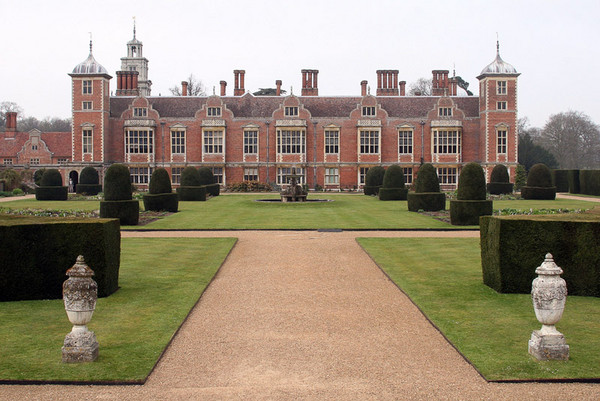
Lady Margaret Butler - (c. 1454 or 1465 – 1539) was an Irish noblewoman, the daughter and co-heiress of Thomas Butler, 7th Earl of Ormond. She married Sir William Boleyn and through her eldest son Sir Thomas Boleyn, was the paternal grandmother of Anne Boleyn, second wife of King Henry VIII of England.
She was born at Kilkenny
Castle in County
Kilkenny, Ireland, the daughter and co-heiress of Thomas Butler, 7th
Earl of Ormond and Anne
Hankford. Her paternal grandparents were James
Butler, 4th Earl of Ormond and Joan
de Beauchamp. Her maternal grandparents were Sir Richard Hankeford and Anne
de Montagu.
Spouse(s) Sir William Boleyn
Issue
Anne Boleyn, Lady Shelton
Thomas Boleyn, 1st Earl of Wiltshire
John Boleyn
Anthony Boleyn
Jane Boleyn
Alice Boleyn
Margaret Boleyn
William Boleyn
James Boleyn
Edward Boleyn
Noble family Butler
Name Birth Death Notes
Anne 18 November 1475 6 January 1555 married John Shelton; had issue
Thomas, 1st Earl of Wiltshire and Ormonde c. 1477 12 March 1539 married Lady Elizabeth Howard; had issue, including Queen Anne Boleyn
John 1481 1484
Anthony 1483 30 September 1493
Jane c. 1485 unknown married Sir Philip Calthorpe
Alice c. 1487 - 1538 married Robert Clere
Margaret c. 1489 unknown married John Sackville, Esq.
William c. 1491 18 December 1571
James c. 1493 5 December 1561 married Elizabeth Wood
Edward c. 1496 unknown married Anne Tempest
The brasses of England - Herbert Walter Macklin
Wanlip, in Leicestershire, has an inscription in English prose, of the date 1393, to Sir Thos. Walsch and Dame Katherine his wife, "whiche in her tyme made the Kirke of Anlep and halud the kirkyard first in wurchup of God & oure Ladye & seynt Nicholas."
...
As soon as jupons were worn over the cuirass they became a vehicle for heraldic display. The ordinary jupon was of leather, and upon this the wearer's arms were sometimes painted. On great occasions the material was changed to embroidered silk or cloth. A few heraldic jupons are met with, and brasses which display them are often of considerable magnificence. Thus, in Southacre Church, Norfolk, 1384, Sir John Harsyck is represented with arms upon his jupon, or, a chief sable indented of 4 points. His lady lies beside him, her right hand resting in his. She was the daughter and sole heir of Sir Bartholomew Calthorpe, knight, of Gestingthorpe, whose father, Sir Bartholomew, married Elizabeth, daughter and sole heir of Sir John de Gestingthorpe, of Essex, and, by reason of his inheritance, assumed the arms of Gestingthorpe, ermine, a maunche gules. Lady Harsyck wears these arms embroidered upon her kirtle, impaled with those of her husband. The knight's arms are also repeated on a shield, surmounted by his helmet and crest of turkey's feathers, placed across the top of the stone. This crest Sir John, his father, was allowed to wear by grant from Sir John Camoys, in the 30th Edward III., and he bore it in a hoop or.
William WALSH was born 1475 in Colby, Norfolk, England. He married Olive CLERE on 1499 in Colby, Norfolk,
England.
Olive CLERE was born 1479 in Stokesby, Norfolk, England. She married William WALSH on 1499 in Colby, Norfolk, England.
Norfolk Record Office - 1544 - William Walsh Colby
1544 - Feoffment. William Walsh of Colby, gent., to Robert Purdy, chaplain of Colby. - 28 Jan 1544
---- >>> Back to Outlawe Index